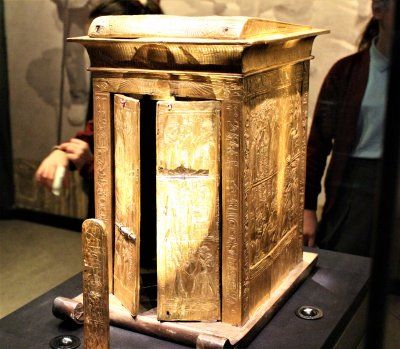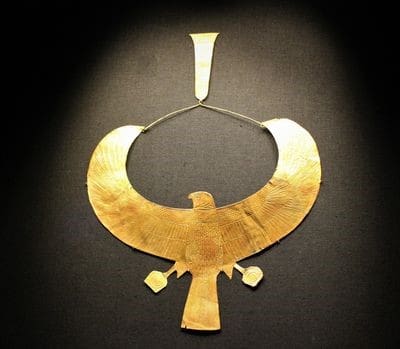HIGHLIGHTS OF THE TUTANKHAMUN TOURING EXHIBITION
- Sarah

- Nov 12, 2023
- 5 min read
King Tutankhamun: Treasures of the Pharaoh was the last ever world tour of the grave goods buried with King Tutankhamun, before they settled into their permanent residence in Cairo. The tour visited Paris, London, Sydney and Tokyo, but for those who were unable to visit the exhibition, this is our photo album of the highlights from when the tour visited London, as a reminder of the last chance many had to see these amazing artefacts.

This gilded wooden fan held 30 ostrich feathers, which would provide a cooling breeze. The inscription on the stick says that Tutankhamun hunted them himself, in the desert near Heliopolis, which is portrayed in the incredibly detailed carving.
Left: Egyptian calcite vases. The central vase is inlaid with faience, a ceramic material with a brightly coloured glaze. Traces of a brown residue was found inside, from an oil which was essential for rituals and highly valued.
Right: A close up of the neck of the vase. Faience was known as ‘tjehenet’ in the ancient Egyptian world, which means ‘dazzling’ or ‘brilliant’. It was a synthetic material and could be made in a variety of colours, although turqousie was the most common, as it was believed to represent life and fertility.
Left: This calcite vase on a stand has cartouches of Tutankhamun and Ankhesenamun inscribed upon it. Ankesenamun was his half-sister and also his wife. They shared a father, but her mother was Queen Nefertiti, who was renowned for her beauty.
Right: This alabaster vase with a stopper, has the name of Tutankhamun’s ancestor, Thutmose III, inscribed upon it. Thutmose III was considered one of the greatest Pharaohs, and a military genius. The vase was used to store perfume or oil for rituals.

This painted calcite box, with a floral decoration on the vaulted lid, contained two bundles of human hair. These probably belonged to Tutankhamun and Ankhesenamun. Found with a small ivory pomegranate, this may well have represented their marriage contract.
The gilded wooden figure of Tutankhamun on a skiff, throwing a harpoon. He is dressed as Horus, son of Osiris. His prey is a hippopotamus, the incarnation of Osiris’ evil brother Seth, who tore apart Seth’s body and scattered it throughout Egypt. Using magic, Osiris’ sister Isis made his body whole again. They then married, starting the tradition of Egyptian Pharoahs marrying their sisters. As the Ancient Egyptians believed that words and images could come alive in the afterlife, the hippopotamus is considered too dangerous to portray.

These wooden boomerangs are made from hardwood and decorated with bark patterns. Due to the curvature, none of these would have been able to be thrown and return, although there were others in the tomb that could do this. Boomerangs were used for hunting by wealthy Egyptians, who would throw them in the marshes to stun and kill birds. These would have been included in the tomb not only to allow Tutankhamun to continue one of his hobbies, but also to help him fight and subdue the forces of chaos he would meet in the afterlife.

This solar hawk Horus figure, a gilded wooden hawk with a sun disk on its head, was part of the decoration of a chariot. The tomb contained six chariots in total, each of them dismantled to pass through the narrow entrance, then reassembled inside.
Left: The original mummy remained in Cairo, but his adornments were on display at the exhibition. The mummy was tightly bandaged to complete his magical transformation and successful resurrection in the afterlife. Amulets and jewellery were folded into the layers, in a precise order determined by magical texts, such as The Book of the Dead.
Centre: Four horizontal and two vertical gold bands are inlaid with carnelian, lapis and glass, which formed hieroglyphs of the king’s name and protective magic spells.
Right: The gold ba-bird pectoral decoration is holding ‘shen’ signs, which represent the eternal journey of the sun.

This lotus chalice was called ‘The Wishing Cup’ by Howard Carter, and was one of the first things he saw when he entered the tomb. Made from a single piece of alabaster, the handles are shaped like lotus flowers growing upwards. It represents the infinite and eternal life of Tutankhamun.
Left: Tutankhamun’s organs were kept in a canopic shrine, which contained a magnificent calcite chest. On top of this, two pairs of Tutankhamun heads faced each other, and slotted inside those, were four intricate gold coffinettes, each containing an embalmed organ. The coffinettes are replicas of the actual coffin. This one contained his liver.
Right: This gold squatting figure and chain is of King Amenhotep III. He was Tutankhamun’s grandfather and always identified himself closely with the gods. The collar of glass beads show his devotion to Ra, the sun god of Egypt. This protective pendant would have been to help Tutankhaumn on his journey through the Netherworld.
Left: This gilded wooden statue of Ptah has three hieroglyphs on the sceptre, which stand for life, stability and sovereignty. Ptah was the god of Creator, and the patron of craftspeople and architects. He was central to Egyptian worship and was linked to the city of Memphis, which was also known as the ‘temple of the soul of Ptah’. The Ancient Greeks shortened this name, using it to refer to the whole country, eventually giving us the name ‘Egypt’.
Right: This life sized statue of the Ka of Tutankhamun marks his passage from the dark night to his rebirth at dawn. The eyes are made from volcanic obsidian and his sandals are bronze. The black skin symbolises the fertility of the Nile, and the gold marks his divinity. It is one of a pair which stood guard in the tomb, the most complete examples of their kind ever discovered.
Left: This incredible gold inlaid pectoral has a lapis scarab and is made of gold, silver, carnelian, turquoise, lapis lazuli, green feldspar and glass. When it was found by Howard Carter, he put it on the excavation’s water boy, Hussein Abdel-Rassoul, and had a photograph taken of him. This famous photograph managed to provide Hussein with an income for the rest of his life.
Right: A wooden gilded mirror case in the shape of an Ankh, made with coloured glass, carnelian and quartz. Mirrors were symbolic of resurrection, and the ankh represented life. Inscriptions around it have Tutankhamun’s name, epithets and his relationship to specific gods.

Pharoahs carried a crook and flail, in honour of Osiris. The crook in particular became the sign of a ruler. Tutankhamun would carry these symbols on formal occasions, confirming his divine authority.

A wooden box inlaid with 47,000 separate pieces of ivory and ebony. An inscription suggests that this held gold jewellery for Tutankhamun’s wedding.
Left: This golden shrine offers a glimpse into the domestic life of Tutankhamun and his wife, showing intimate scenes of domestic harmony within the royal household. Tutankhamun pours oil for her, she puts a collar on his neck, he aims his bow at birds while she hands him arrows. These images, along with others on the shrine such as the ducks, lotuses and necklaces, along with the hieroglyphs for verbs such as ‘shooting’, ‘pouring’ and ‘throwing’, all carry sexual overtones.
Right: This Wesekh, or collar, was placed between the mummy’s layer of bandages. The hawk represents Horus, the god closely associated with the living Pharaoh. These collars were worn by gods and Pharaohs, and were often of such a weight that a counterpoise hung down between the shoulder blades of the wearer, to help them maintain balance.
Left: This gilded wooden shield shows Tutankhamun wearing an Atef crown as he holds two lions by the tails. Lions were the most powerful animals of the natural and supernatural world, surrounding Egypt in the desert lands. By showing his mastery of these animals, he is showing his mastery over Egypt.
Right: This shield has the King as a Sphinx, trampling on Nubian enemies underfoot. The hills at the bottom make the hieroglyph ‘foreign land’, showing how he is conquering his enemies. Due to the carvings on these shields, they are likely to be ceremonial rather than functional.

There were 35 model ships inside the tomb, as the Ancient Egyptians believed that the power of magic would make them full size and functional in the afterlife. This one is a wooden solar boat, which has a throne and two steering paddles.










































Comments